No more 'princes of the Church'—the Pope's new model for the College of Cardinals
By Phil Lawler ( bio - articles - email ) | Jan 05, 2015
Whenever a Pope announces a consistory, and names a new set of cardinals, commentators hasten to interpret the papal choices. But on Sunday, when Pope Francis identified his latest selections, most commentators—myself included—drew a blank.
To be quite honest, among the 20 names announced by the Holy Father, only one was familiar to me. Archbishop Dominique Mamberti, now the prefect of the Apostolic Signatura, was formerly the Secretary for Relations with States—the Vatican’s equivalent of a foreign minister. In that role he was prominent but prudent. A seasoned Vatican diplomat, he made few public statements, and when he did speak he steered clear of controversy.
So I know virtually nothing about this new cohort of cardinals. I cannot say where they stand on the contentious issues facing the Catholic hierarchy, whether they will be classified as “liberal” or “conservative,” whether Pope Francis has chosen reliable supporters of his policies (whatever they may be) or potential critics. But I feel sure those questions are beside the point.
What were the Pope’s intentions when he chose these new cardinals? Certainly he planned to increase the geographical diversity of the College of Cardinals. He wanted to give greater weight to the global south: the region in which the Church is now growing most rapidly. In those respects the Pope’s intentions were evident, and no analyst failed to notice them. But there’s more to it than that.
The archbishops named by Pope Francis are drawn disproportionately from communities that are in pain: from Myanmar, a nation slowly emerging from under a brutal dictatorship; from Vietnam and Ethiopia, where the Church has suffered political oppression; from an Italian diocese coping with a flood of impoverished immigrants and a Mexican diocese ravaged by the violence of drug traffickers. With these choices the Pope accomplishes two things. First, he reminds us of the suffering that hundreds of millions of people endure every day, and of our obligation to address their needs. Second, he gives pastors who are experts on human suffering a greater voice in the leadership of the universal Church.
Many commentators, particularly in the US, have drawn attention to the fact that the Pope passed over a number of archbishops from the so-called “cardinalatial” sees. It is indeed striking that among the archbishops of Los Angeles, Chicago, and Philadelphia, not one will be wearing a red hat next year. But that was predictable. Pope Francis has already indicated that he will not be bound by tradition in giving out red hats; his latest selections only underline that message. (It is odd, therefore, that some observers are confidently predicting that Archbishops Gomez, Cupich, and Chaput will be named cardinals at the next consistory. In light of this Pontiff’s choices to date, that outcome now seems unlikely.)
To appreciate what Pope Francis is doing to the College of Cardinals, it helps to consider the background of the institution. Originally the cardinals represented the clergy of the Diocese of Rome, who would meet to elect a new Bishop of Rome. But those days are long past. The Archbishop of Bombay clearly does not represent the clergy of Rome—to say nothing of the Major Archbishop of Trivandrum, who is not even a member of the Roman Catholic Church.
As the College of Cardinals became an international body, and even embraced the leaders of the Eastern churches in communion with Rome, a different model emerged. The cardinals were often described as the “princes” of the Church. They were important prelates from historic archdioceses, with their own considerable spheres of influence. The “cardinalatial” sees were the world’s wealthiest archdioceses, the most important Catholic centers outside Rome.
Pope Francis has taken direct aim at this model. Since he envisions a Church without “princes,” he sees no need for an ecclesiastical aristocracy.
The College of Cardinals has two distinct responsibilities: to provide advice for the Roman Pontiff, and to select his replacement when he dies (or resigns). These are important responsibilities, calling for prelates with spiritual depth and discernment. But the tasks of a cardinal do not necessarily require great administrative ability. A bishop who is ideally suited to run a large metropolitan archdiocese may not have the qualities needed in a cardinal, whereas another bishop who would be out of his depth in a major see could be an excellent counselor to the Pope.
As Pope Francis sets out to remodel both the College of Cardinals, John Allen observes that the Holy Father is taking a real risk. As he breaks down the traditional influence of the “princes of the Church,” the Pope might unintentionally enhance the power of Roman Curia, another institution he hopes to reform. Allen explains:
Vatican insiders will tell you that when the cardinal of, say, Chicago, or Cologne, or Milan, shows up in their offices, he’s taken seriously indeed. Those are all places where a reigning cardinal presides over an infrastructure and a payroll that are actually much larger than the Vatican’s, where he usually enjoys a high media profile and perceived political clout.
The new cardinals from Bangkok and Cape Verde and Tonga will not be able to promise the same benefits that the archbishops of Chicago, Cologne, and Milan can deliver. So by decentralizing the College of Cardinals, the Pope may allow the tides of ecclesiastical influence to ebb back toward Rome. To succeed in his program of reform, Pope Francis must decrease the power of both the “princes of the Church” and the bureaucrats of the Curia, simultaneously. It won’t be easy.
All comments are moderated. To lighten our editing burden, only current donors are allowed to Sound Off. If you are a current donor, log in to see the comment form; otherwise please support our work, and Sound Off!









